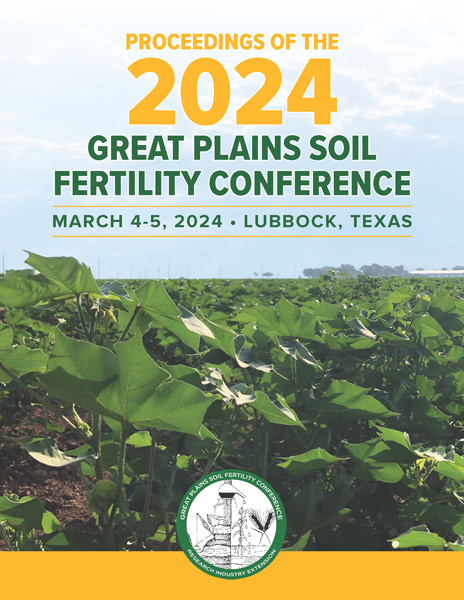Conference Proceedings Available!
Proceedings
Authors
| Filter results9 paper(s) found. |
|---|
1. Nitrogen Fertilization and Long-term No-tillage Impacts on Soil Properties and Deep Soil C Storage Under IrrigationThe net soil greenhouse gas mitigation potential of conservation agricultural management practices is strongly influenced by the direction and magnitude of soil organic C (SOC) change in deep soil layers (>6”). Deep SOC is typically old, highly processed, and consists of microbial products and root exudates associated with clay and other minerals. However, it can be susceptible to decomposition and priming from the addition of new, labile organic C. We examined long-term soil C dynamics... C. Stewart, D. Manter, J. Delgado, S. Del grosso, F. Calderon, K. Heckman, K. Snell |
2. Phosphorus Fertilizer Management and Cover Crop Effects on Phosphorus Loss from No-till Corn and Soybean.Loss of phosphorus from non-point source agricultural sources is a known contributor to the degradation and contamination of surface waters. Therefore, it is imperative to adapt agricultural best management practices which promote and preserve surface water quality. The goal of this study was to quantify the impacts of phosphorus fertilizer management practice (placement and timing) and winter cover crop on concentrations of total suspended solids, total phosphorus, and dissolved reactive phosphorus... E. Carver, N. Nelson, K. Roozeboom, G. Kluitenberg, P. Tomlinson, J. Williams |
3. Nutrient Partitioning Changes in the Past 30 Years of Cotton ProductionModern cotton (Gossypium hirsutum L.) cultivars are more compact and efficient due to optimization of genetics and changed management practices in the past 30 years. The most recent work evaluating nutrient uptake by cotton was done in early 1990s, hence a need to re-evaluate the nutrient accumulation and requirements in modern high productivity cultivars. The objective of this study was to compare the resource allocation of modern cotton cultivars (PM HS26, FM 958, and DP 1646)... I.B. Pabuayon, G. Ritchie, K. Lewis |
4. Relationship Between Plant Nitrogen and NDVI of Cotton on the Texas High PlainsNitrogen (N) is one of the most limiting factors in Texas High Plains cotton production (Bronson et al., 2001). Nitrogen build-up in cotton is near maximum for the season at first open boll, when leaf senescence begins (Li et al., 2001). Lint yield response to N is difficult to predict due to N response relying on water management and initial soil nitrate (NO3--N) (Morrow and Krieg, 1990). Normalized difference vegetative index (NDVI) is a tool that has been used to manage... A. Bumguardner, K. Lewis, G. Ritchie, K. Bronson, M. Maeda |
5. Nitrogen and Sulfur Colimitation to Winter Wheat YieldSulfur has become more limiting for wheat production in the Great Plains, and its deficiency can interact with N availability. The current work reports on yield and yield gaps of three winter wheat varieties as affected by N and S fertilization using the concept of co-limitation (CNS). Field studies evaluating 0, 10, 20 and 40 lbs S/a combined factorials with 50, 100, and 150 lbs N/ac and three hard red winter wheat varieties were conducted in eight environments resulting from the... R. Lollato, B.R. Jaenich, N. Nelson, M. Guttieri, D. Ruiz diaz, V. Sadras |
6. Temporal and Spatial Variability of Nitrogen Use Efficiency Across Landscape Positions in Southern High PlainsOptimizing nitrogen use efficiency (NUE) is crucial for enhancing crop productivity, managing resources effectively, and promoting environmental sustainability. In response to the growing significance of sustainable agriculture, this research rigorously explores the temporal and spatial dynamics of NUE in the unique agroecosystem of the Southern High Plains. With a focus on precision nitrogen management tailored to the region's distinctive conditions, the study aims to provide valuable insights... R. Karn, W. Guo, K. Lewis, G. Ritchie, M. Siebecker |
7. Developing Nitrogen and Phosphorus Fertigation Strategies in CottonSubsurface drip irrigation (SDI) is becoming a popular option for maximizing the water use efficiency of cotton (Gossypium hirsutum), especially in semi-arid environments of the Midsouth and Western United States. In the Texas High Plains where underground water resources from the Ogallala Aquifer are rapidly declining, there is increased adoption of water conservation technologies like center pivot and drip irrigation. In addition to increased water efficiency, drip irrigation allows... K. Lewis, H. Valencia, T. Roberts, J. Burke, G. Ritchie |
8. Comparative Analysis of Resource Partitioning and Nutrient Uptake Efficiencies in Modern Cotton CultivarsUnderstanding the complex process of resource partitioning within the plant provides prospects to develop new crop improvement strategies for varying environmental factors and agronomic practices. In upland cotton, the partitioning of dry matter is as crucially important as that of macronutrients and micronutrients in improving productivity. This presentation highlights research works pertaining to the changes in macronutrient and micronutrient uptake and partitioning alongside the remarkable... I. Pabuayon, K. Lewis, G. Ritchie |
9. Evaluation of the Nutrient Requirements and Uptake Indices of Ten Modern Cotton CultivarsThis study aims to re-evaluate the partitioning patterns and nutrient uptake index of new and soon-to-be released cotton cultivars to optimize the nutrient inputs for farmers and producers. The study will be divided into two phases: Phase I will be the determination of different nutrient uptake indices of 10 modern cotton cultivars and Phase II will be the development and establishment of new fertilizer management strategies for modern cotton cultivars using the results of plant nutrient uptake... J. Bicaldo, K. Lewis, G. Ritchie |
